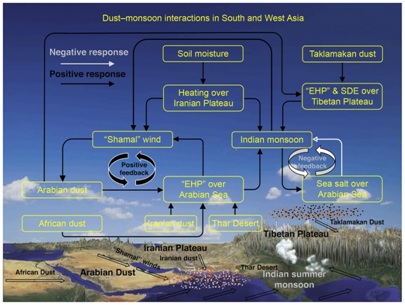

New research conducted at the University of Kansas suggests that the positive dust–monsoon correlation can be partially attributed to the heating of the Iranian Plateau.
Context
New research conducted at the University of Kansas suggests that the positive dust–monsoon correlation can be partially attributed to the heating of the Iranian Plateau.
Background
- Monsoon is a familiar climatic phenomenon though little known.
- Despite the observations over centuries, the monsoon continues to perplex scientists.
- Many attempts have been made to discover the exact nature and causation of the monsoon, but so far, not a single theory has been able to explain the monsoon in its entirety.
- Recently when it was studied at the global rather than at regional level a real breakthrough has come
Analysis
What is the mechanism of the Indian Monsoon?
- Till 19th century, it was believed that the continentality during the summer responsible to set start the flow of monsoon winds towards the Indian subcontinent
- When the sun shines vertically over the Tropic of Cancer during April and May, the Indian subcontinent in the north of the Indian Ocean gets heated intensely. This leads to the formation of intense low pressure in the northwestern part of the Indian subcontinent.
- Due to continentality, the pressure in the Indian Ocean in the south of the subcontinent is high as water is heated slowly, the low-pressure region attracts the southeast trade winds across the Equator. These conditions help in the northward shift of the ITCZ.
- The southwest monsoon may thus, be seen as a continuation of the southeast trade winds deflected towards the Indian subcontinent after crossing the Equator due to the Coriolis effect.
- These southeast trade winds cross the Equator between 40°E and 60°E longitudes.
- The upward shift in the position of the ITCZ is also related to the withdrawal of the westerly jet stream from its position over the north Indian plain, south of the Himalayas.
- Only after the western jet stream has withdrawn itself from the region the easterly jet stream sets in along 15°N latitude. This easterly jet stream is held responsible for the onset of the monsoon in India.
- However, the aerosol present over the Arabian Sea, Iranian Plateau, and southward slope of Tibetan plateau plays an important role in modulation of South Western Indian Monsoon
What are aerosols?
- An aerosol is a suspension or colloid of fine solid particles or liquid droplets in a gas medium. Aerosol comes from both anthropogenic (industry, motor vehicles), and natural sources (forest fires, oceanic haze, deserts). For example soot (black carbon), organic carbon, dust, sea salt.
- If these particles are sufficiently large we observe their presence when they scatter and absorb sunlight. The scattering of sunlight can reduce visibility (due to the formation of haze) and redden sunrises and sunsets.
How aerosols affect the Indian monsoon?
- The heavy aerosol layers mainly composed of anthropogenic aerosols, including black carbon and sulphate, over South Asia can cool the surface by scattering and absorbing the solar radiation, which reduces the ocean–land thermal difference and in turn weakens the Indian Monsoon, this is called “global dimming” or “solar dimming” effect.
- On the other hand, aerosols (e.g., black carbon and mineral dust) that absorb sunlight reducing the albedo, accumulate over the southern slope of the Tibetan Plateau heats the mid-troposphere, strengthening monsoon convection over North India. This is referred to as the Elevated Heat Pump (EHP) effect.

What is Aerosol Optical Depth?
- Aerosol optical depth is a measure of the extinction of the solar beam by dust and haze in which particles (dust or smoke) in the atmosphere blocks sunlight by absorbing or scattering light.
- AOD tells us how much sunlight is prevented from reaching the ground by these aerosol particles.
- A value of 0.01 corresponds to an extremely clean atmosphere, and a value of 0.4 would correspond to a very hazy condition
Aerosol Optical Depth above Arabian Sea Region
What is the reason for high AOD around Arabian Peninsula?
- Over the Arabian Peninsula and the northwestern Arabian Sea, more than 50% of the AOD is contributed by mineral dust.
- Tons of dust aerosols emitted from the Arabian Peninsula and its surrounding areas are transported to the Arabian Sea by the strong north-westerly “Shamal” winds during boreal summer.
How high concentrations of aerosol over the Arabian Sea affect Indian Monsoon?
- The dust aerosols over the Arabian Sea could heat the lower and mid-troposphere, forming a heat low over the Arabian Sea which strengthens the south-western monsoon branch
- Observations showed that AOD over the Arabian Sea and the southern Arabian Peninsula is significantly and positively correlated with the Indian Monsoon rainfall in the southwest coastal regions, Northern Central India, and the southern slope of the Tibetan Plateau.
- A global model simulation showed that the monsoonal rainfall responses to dust are negative in Northeast India yet positive in South India.
Correlation between the heating of Iranian Plateau and Arabian Dust and Indian Monsoon
- The summertime temperature in the mid-troposphere over the Iranian Plateau was found to be positively correlated with:
- Indian Monsoon rainfall at the inter-decadal timescale from 1967 to 2015, and
- Summertime near-surface Shamal wind and AOD over the Arabian Peninsula and the Arabian Sea from 2000 to 2013.

Conclusion
The researchers proposed a hypothesis that the observed positive dust–monsoon correlation could be partially attributed to the heating over the Iranian Plateau, which could intensify the dust emissions over the Arabian Peninsula through strengthening the “Shamal winds” as well as the Indian Monsoon circulations and rainfall at the inter-decadal timescale.
Many factors could contribute to the mid-troposphere temperature variation over the Iranian Plateau, and further studies are needed to identify them. However, it is noteworthy that soil moisture and dust are two potential factors that can influence the mid-troposphere temperatures over the Iranian Plateau.


